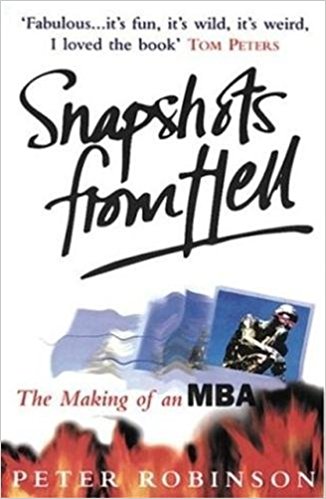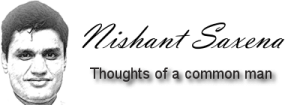Author : Peter Robinson
Genre : Management, Non – Fiction, Self-Help

MBA is not just a course, it is an experience. Even after 20 years in a corporate career, I would have used hardly 20% of the actual content I was taught as part of the syllabus. But the behavioural and experiential learning: the vast network with colleagues and faculty, the late night outs and the ethos of diligence, the deep friendships that separates the genuine from the superficial, the co curricular contests and exposure, the case study preparation and class participation, the research needed to submit papers, the concept of ‘relative’ assessment, the whole attitude shifting from class-room study to all round and self directed development… these have indeed stayed me me even after two decades.
Arpita Phatak from Wellingkar business school in Mumbai, India joins us as guest contributor towards this book review and summary.
***
Snapshots from Hell is a book based on Peter M. Robinson’s MBA journey at Stanford Business School, one of the top 3 in the world. His day to day impressions and experiences written in his personal journal evolved into this book. Peter, before he joined the MBA program, was a Presidential Speechwriter at White House. Seeking a more lucrative career path, he applied for and was selected at Stanford. Having a major in English and expertise in Politics, Philosophy and Economics, he came to this course with no experience in Quantitative studies, technically ‘a Poet’, as Students with no business background are known at many business schools. “If some people are color blind, others, like me, must be number blind.”
“One term at Business school had begun to make me a different person.”
Every year, especially in India, millions of students apply for an MBA degree, all looking to make something of themselves and to make money. All looking for an answer to the question, what is business school like? Peter attempts to answer this question with the help of his experience at one of the best business schools in the world.
“Background, Status – none of this mattered; at business school, we would remake ourselves.”
“You thought you were here to study? Wrong – You’re here to get a job.”
The initial days are interesting. To go to a pre – term Math Camp and Computer Camp, just to catch up with your classmates whom you haven’t even met yet. On the orientation day, Peter gets to see his entire 333-member batch for the first time. Where the school assures them that they are in the best hands and also warns them that if they want to get the best out of these two years, they should not waste even ten minutes.

Stanford that year, took in students from 21 countries, creating a huge pool of different ideas, minds, profession, social and financial class.
“I met a Navy Pilot who has landed fighter planes on carriers, three medical Doctors.”
“Among the women in our class I met a Classical Pianist, a neurosurgeon, and the Finance Director of a presidential campaign.”
Stanford has a core curriculum which is a set of thirteen courses in which every candidate has to get a passing grade or they drop out of the institution. These thirteen courses were tough and hence support groups were organized with trained counselors.
“It’s like boot camp, you know, basic training. Crawling through mud, like trying to drink from a water hose.”
The classes were the usual Amphitheaters with a teaching well, where there was a backdrop of blackboards, even the row you sat in said a lot about you. Front rows were where teacher’s pet or class clown sat, cool kids sat on the highest deck, Peter usually found himself in the middle row seats where students who didn’t wanted to stand out used to sit.
Students usually stayed up late night, sometimes till 3 o’ clock in the morning, trying to make sense of whatever was taught earlier in the day. Getting up groggy and sleepy for the class next morning. Classroom life was not only intense but hectic too. Peter counted on the relaxation he was going to get by socializing around but which was not to be had as everyone was concentrating on staying alive in this tsunami of huge syllabus.
As the midterms approached, the atmosphere got even more tense, pushing some students into a crying fit and some into sleepless horror filled nights. Even though the institute did not share the marks of students with the placement companies, still everyone was scared that they might just flunk the test. During finals as the students were already scared about their performance, they needed a field marshal to guide them out of the war zone which came in the person of Professor Yeager, who was merciless and strict but easy to rely on. The students hated him at first. Professor Kemal was young, inexperienced, and friendly and was scorned upon in the end, as a direct result to the fear felt by the students.
It is an established rite at Stanford for students to have lunch with the faculty members, for networking and to build a rapport. [This is very unique when compared with Indian Business Schools, where power distance between teachers and students is much higher].
The most important part of doing an MBA was to find a job. Peter found himself to be searching for the specialization to work in after a rather negative experience he had at his summer internship at an Investment banking firm. Hence began the Job-hunting season for Peter: he interviewed with Robert Maxwell and for position in the team of late Steve Jobs. He did like the people but not the sound of the job description. Finally, he landed himself a job with Rupert Murdoch, founder of Fox Production company, only to lose it later when the recession hit in 1990. This happened with many of his classmates, and those who did manage to hold their position were always laden with fear and anxiety. At the end everyone gets a job, some easily and some after struggling for more than a year. So, the obvious question one might ask is, “What did Stanford do for the Students?”
“This business school admits proven performers, lets them play around for two years in a sunny setting, then takes credit for everything they do afterward”

Graduates walking towards future
But one thing was of certitude that without a Stanford graduating degree in hand, Peter wouldn’t have even gotten a placement interview with these reputed firms. “Call an MBA a signaling Device or a yuppie union card. It works.”
The amount of hard work and heartbreak, along with the many lessons that goes into making of an MBA is beyond words.
“Business school taught us that there is no ideal state of ease and success.”
Peter, now a member of Hoover Institution and a famous writer, is hilarious and insightful towards life of an MBA. His candid and frightening firsthand account of life as a ‘poet’, among classmates who already had a career in business, already had worked with huge names, came from different countries – all this making it more difficult to maintain morale and sanity, along with soul crushing syllabus and never-ending exams – takes one’s breath away.
“Is it a source of comfort that my non – poet roommates are still awake, studying as hard as I? No. I conclude that if they must work hard, then I am finished.”
“Soon I quit repeating ‘It can be done’, ‘Don’t let the bastards grind you down’ seemed more fitting.”
“Life was funny, but as long as it worked in your favor, who could complain?”
Why you should read this book : This book mainly appeals to future MBA aspirants and current MBA students. Telling them what are they up for. The fears, insecurities, tough competition that they would face is all normal and very much to be looked forward to. The book especially can be most relatable to students who are not from mathematical background, how difficult can it be for them to keep up with the pace and how they still can be a success if they worked hard enough and believed in themselves.
Goodreads Link: Snapshots From Hell: The Making Of An MBA by Peter M. Robinson | Goodreads

 This information will never be shared with third party
This information will never be shared with third party
Just finished reading this book. I would say this is a very well written article. Does complete justice to the book.
this really nees be read.
Putting this in my reading list….
This is so unique and also the need of the hour and Arpita you rock !!
Great review! Would definitely read this book!! Good going Arpita!!
A must read book. Very inspiring and refreshing.
This is such a great review article..!